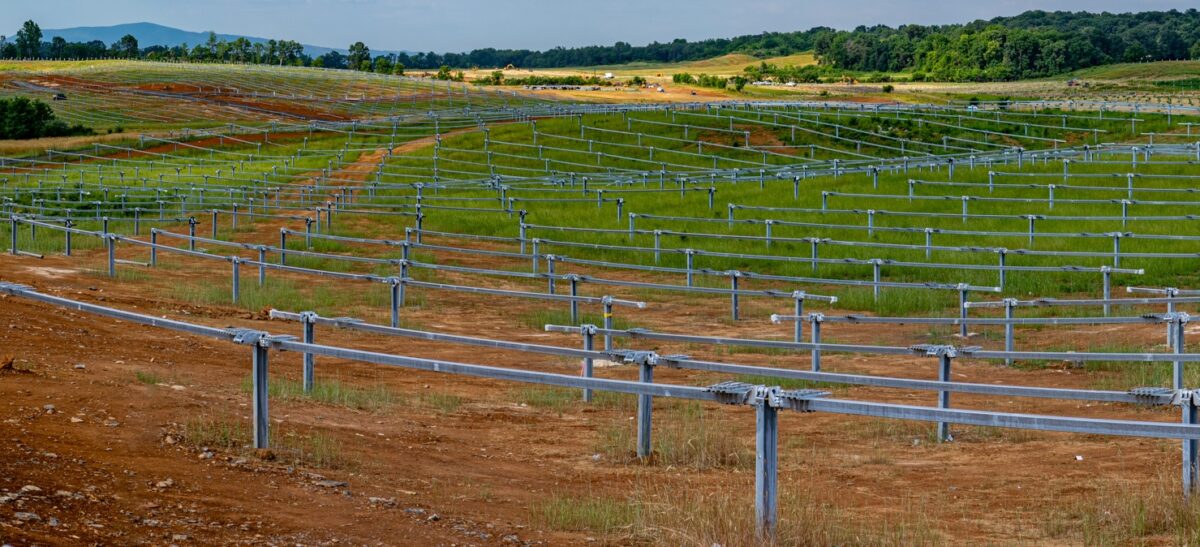Few solar development sites are flat, because the world is not flat. And that poses a problem for conventional solar mounting systems, which weren’t designed to handle the undulations and hills that project developers routinely encounter.
Solar’s astounding growth means that more projects are being sited on ‘topographically challenging’ ground. But the mounting systems that literally support the solar industry grew up on flatter land, with at least some grading assumed.
For one recent 170-MW project on rolling terrain in Virginia, grading the site flat would have meant moving the equivalent of 123 Olympic swimming pools’ worth of dirt and adding roughly $10 million in construction cost.
All that grading stirs up dust clouds and runoff, sacrifices topsoil, and sends dump trucks through towns, driving up community concerns along with project budgets. These terrain challenges are only getting more acute as the industry grows. So today, a more holistic approach is required when siting solar.
The toll of grading for conventional trackers
Conventional solar trackers use a single torque tube that spans an entire row. This design works well for flat sites, and less so in almost every other case.
For starters, hardly any site is truly flat. Suppose you were to build a solar array on an American football field. That field may look flat, but it actually has a one-foot rise in the middle so that water runs off — which you’d have to account for with your foundations.
To compensate for the rigidity of conventional tracker systems in a non-flat world, solar developers typically have brought in earthmoving equipment to grade a site level enough to handle a traditional tracker system. All that grading adds to project development costs and leads to other serious problems.
Dust clouds raised by site grading have been so bad as to close a nearby interstate highway, forcing developers to bust their budgets on measures to suppress and mitigate the dust. Trucks constantly prowl these earthmoving operations, spraying thousands of gallons of water to keep dust from rising.
In Colorado, a solar construction firm spent more than $3 million and hired six full-time people just to implement dust control measures at the site of a 200-MW solar project. The efforts still fell short and local officials slapped more than $220,000 in fines on the developer. Those officials found that dust from the site affected the health and wellbeing of local residents.
And in Virginia, grading at two solar projects affected local farmers and led not only to financial penalties on the asset owners, but also contributed to long-term regulatory measures. One poorly graded site led to so much sediment runoff that a local creek turned brown. In that instance, the asset owner was fined $245,000 for the environmental mess created.
These issues don’t just affect individual projects. In 2022, Virginia’s Department of Environmental Quality issued more restrictive stormwater and permitting requirements for solar projects in response to concerns over water quality, deeming solar panels to be impervious surfaces. Community concerns have also spurred individual counties in the state to enact regulations and solar moratoria to restrict project development.
To be sure, site grading can fuel local opposition that can scuttle an otherwise beneficial project.
And these surprises can come up throughout the life of a project, so getting construction permitting doesn’t mean a developer is in the clear.
The industry is still talking about one farmer who learned that his land would be graded flat. He not only turned down a revenue-producing solar lease, but helped organize other farmers to oppose the project’s permit.
Grading—and the environmental damage that comes from forcing a site to conform to rigid tracker specs—is solar’s dirty little secret. The best way to mitigate this risk is to just stop grading.
Learning to love nature’s curves
It’s a given that rolling terrain isn’t going away. So it makes sense to deploy tracker technology that works with the land rather than fighting it, by using designs that offer highly flexible bearings, non-continuous torque tubes, and standardized short piles that reduce the steel requirement.
All-terrain trackers from Nevados, the first manufacturer to develop them for the industry, can accept angle changes of up to 15 degrees (26%) between posts, and all bearings can handle maximum slopes of up to 20 degrees (37%), although standard piles are typically limited to installation on maximum slopes of 11 degrees (20%).
Nevados offers three separate bearing options to allow the torque tubes to angle up and down with the terrain within a ‘cradle,’ for a structure that is highly adaptable to naturally variable topography. Bearing types are mixed and matched throughout a project site to maximize available land for solar deployment, using custom design software that comes bundled with controls and engineering services for more complex sites.
Data gathered as part of the planning and construction of one 50 MW solar facility in Louisiana, which tested all-terrain trackers on an ungraded portion of the site, found they could reduce grading requirements and disturbed land acreage by at least 95% if not more.
Elsewhere, this seemingly simple technology has opened up potential greenfield sites that had previously been deemed non-viable for utility-scale installation. Older sites that used fixed-tilt racking could potentially be upgraded to increase energy yield.
A robust American supply chain can also help a project qualify for domestic content adders to the solar Investment Tax Credit under the Inflation Reduction Act.
The inherent risks and harms due to excessive site grading are easily avoided with such more flexible trackers, which experience has shown can also improve a project’s chances of winning community acceptance.

Yezin Taha is founder of Nevados Engineering and innovator of the first all-terrain solar trackers for uneven terrain.
pv magazine will host a webinar with Nevados on all-terrain trackers on October 30, at 12 p.m. EDT.
The views and opinions expressed in this article are the author’s own, and do not necessarily reflect those held by pv magazine.
This content is protected by copyright and may not be reused. If you want to cooperate with us and would like to reuse some of our content, please contact: editors@pv-magazine.com.








You sure about those claims?